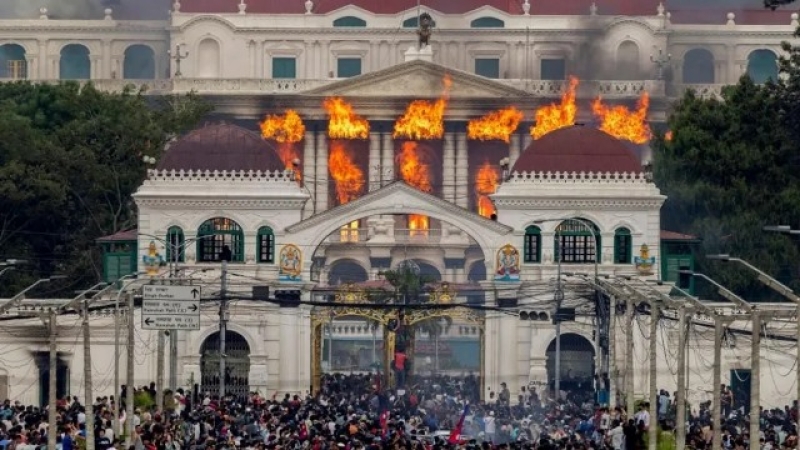- Exporters to import duty-free raw materials: NBR Chairman |
- Gaza aid flotilla activists say second boat hit by suspected drone |
- Shibir-backed candidates win top DUCSU posts with big margin |
- Female dorm Ruqayyah Hall comes up for Shibir this time |
- Bangladesh 2024, Nepal 2025: Youth Movements Force Leaders Out |
About Nepal anti-corruption protests as PM resigns

Nepal Parliament set on fire after PM resigns
Nepal's Prime Minister KP Sharma Oli has resigned in the wake of public outrage over the killing of 22 people in police clashes with anti-corruption protesters.
His office said he had stepped down to pave the way for a constitutional solution to the massive youth-led protests over widespread allegations of corruption and sparked by a social media ban, which has since been withdrawn.
The protests turned violent as thousands – many identifying themselves as Gen Z on placards and banners – took to the streets of Kathmandu on Monday.
Almost 200 people are believed to have been injured in clashes with police, who used tear gas, water cannons and live bullets as protesters scaled the walls of the parliament and other official buildings.
The protests continued on Tuesday, with demonstrators setting fire to the parliament building, the headquarters of the Nepali Congress Party and the home of former prime minister Sher Bahadur Deuba. The homes of several other politicians have also been vandalised.
Here's what we know about the protests.
What was the social media ban?
Social media is a big part of Nepali life. Indeed, the country has one of South Asia's highest user rates per capita.
The demonstrations were triggered by the government's decision last week to ban 26 social media platforms, including WhatsApp, Instagram and Facebook, for failing to meet a deadline to register with Nepal's ministry of communication and information technology.
Critics accused the government of seeking to stifle an anti-corruption campaign with the ban, which was repealed on Monday night.
While the ban was a catalyst for the current unrest, protesters are also channelling a more deep-rooted dissatisfaction with the country's authorities.
What is happening across Nepal?
The ensuing demonstrations turned violent in Kathmandu and some other cities in Nepal, with 19 protesters dying in clashes with police on Monday.
Nepal's Minister for Communication Prithvi Subba told the BBC later that day that police had had to use force - which included water cannons, batons and firing rubber bullets.
Some protesters managed to breach the perimeter of the parliament building in Kathmandu, prompting police to impose a curfew around key government buildings and tighten security.
On Tuesday, protesters also set fire to parliament in the capital Kathmandu, sending thick black smoke billowing into the sky. Government buildings and the houses of political leaders were attacked around the country.
At least three people were reported to have been killed on Tuesday, bringing the total death toll to at least 22 since the unrest began.
Many of the injured have been taken to local hospitals where crowds have gathered. BBC Nepali spoke to doctors who said they had treated gunshot wounds and injuries from rubber bullets.
Police have said several officers were also wounded, with casualty figures expected to increase.
Who is calling the shots now?
On Tuesday evening, Nepal's army chief, General Ashok Raj Sigdel, issued a statement accusing demonstrators of taking advantage of the current crisis by damaging, looting and setting fire to public and private property.
If unrest continued, the statement said, "all security institutions, including the Nepal Army, are committed to taking control of the situation."
At the same time, Gen General Ashok Raj Sigdel invited protesters to engage in dialogue to find a solution to Nepal's worst unrest in decades.
It remains unclear, however, who is leading the country at this point.
The army's statement doesn't clarify what action it could take, or if it would use force to control the protesters. But they are already on the streets to exercise control over those "who are trying to take advantage from the adverse situation in the country and are involved in looting, arson and vandalism".
It's also unclear who will represent the protesters if they do engage in dialogue with the army. These protests have not been led by a group or a person, and in fact started as a response to a callout on social media platforms.
The one political figure who has openly supported the protest is the Mayor of Kathmandu Metropolitan city, Balen Shah. He has been making appeals for restraint from his social media account. – BBC News

